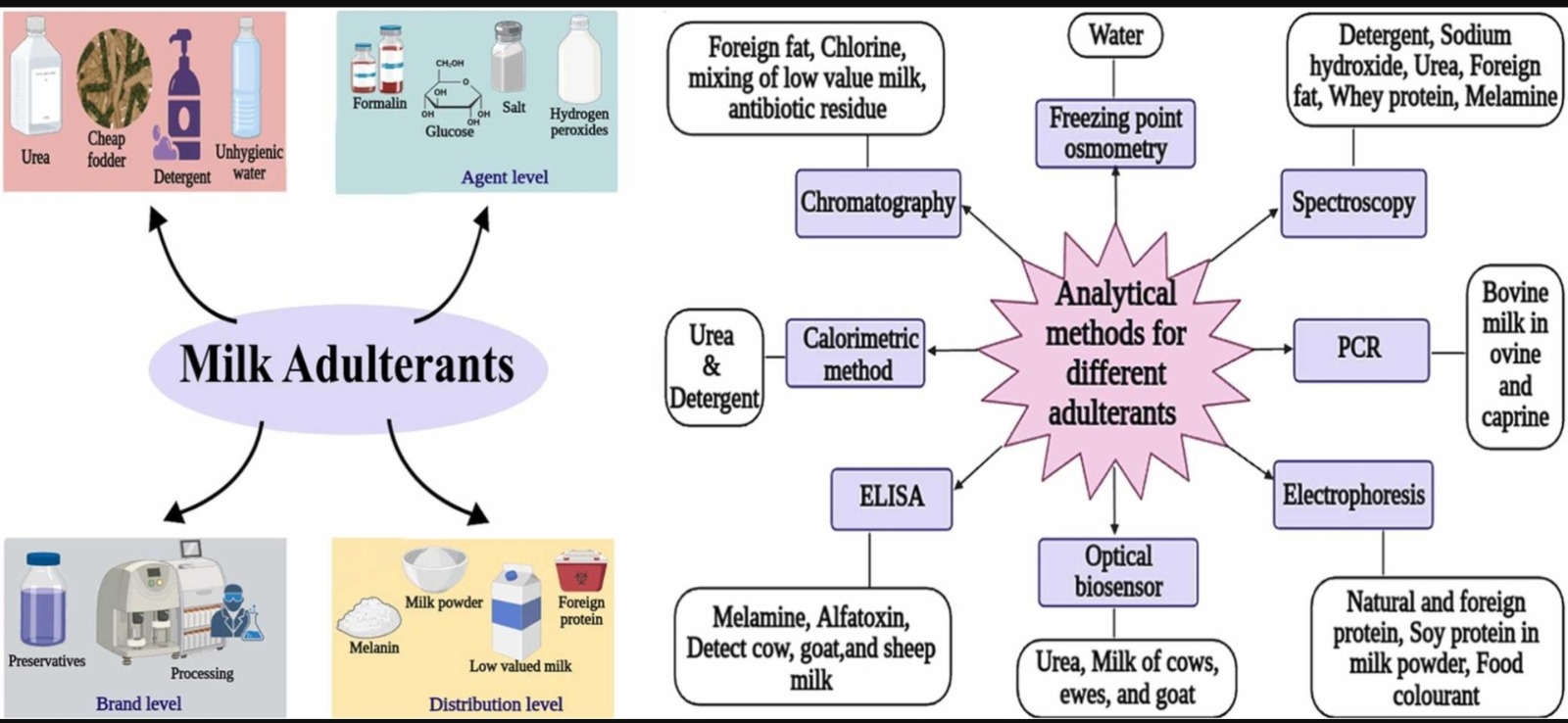I shall discuss milk adulteration in two phases.
Here, in the first phase, I shall discuss common adulterants to milk and their mode of action inside milk. In next blog, I shall discuss how to detect those, by common people.
COMMON MILK ADULTERANTS IN MILK:
- Starch
- Annato Color
- Baking Powder
- Pesticides
- Penciling Powder
- Saccharin
- Urea
- Formalin
- Hydrogen Peroxide
- Powdered Soup
- Glucose
- Common Salt
STARCH:
If a potato is crushed inside water, some milky water comes out of it. It is starch. Again, Maida with water is good source of starch for milk. Let us not discuss how this is done as it would instigate each seller to adulterate milk in a convenient way.
Starch, as such is not detrimental to health. But, with starch in milk, the solid content of milk is increased, for which we pay more price. Milk solids are mostly milk proteins. With starch, we pay more for small amount of protein we receive through adulteration.
SUGAR:
Sugar, again added, to make milk tastier, which is not desirable. We pay for lactose in milk. So naturally a high price for milk, for low quality milk.
ANNATO COLOR:
It is added to have a natural color to adulterated milk. However, it is not much detrimental to health. But large amounts in milk, again a danger to human health.
BAKING POWDER:
These contain mostly sodium bicarbonate, which is a base (an alkaline material). So, naturally a base, neutralizes acid. Milk is a good source of food for micro organisms (bacteria, fungus etc) which are abundant everywhere in the atmosphere. When milk is exposed to atmosphere, these micro organisms feed on it & they release different acids which help in curdling of milk quickly, and thus it reduces the freshness of milk. The bicarbonate or say the alkaline material neutralizes the acid and milk remains fresh more time. It does not become acidic.
Inappropriate use of bicarbonate in food can lead to a condition called alkalosis, where blood becomes too alkaline. This can cause headache, nausea (vomiting), muscle pain etc.
PESTICIDES:
Pesticides usually when added to milk, the milk is kept fresh for more time due to restricted growth of micro organisms in milk. But, everybody knows the effect of a small amount of pesticide on human health.
PENCILLIN POWDER:
Penicillin is anti bacterial. So when added to milk, the freshness of milk is preserved for more time. But, prolonged & erratic use of penicillin as food may create bacterial resistance in human body and body may not respond to a penicillin treatment, in time of requirement, which is very fatal sometimes.
SACCHARIN:
It is added in lieu of sugar. Inappropriate amount of saccharin may disrupt growth of good bacteria in gut, increases risk of obesity & diabetes. It also alters the function of kidney & liver. Some humans have skin allergies due to saccharin in food.
The common lassi, we drink alongside the road, are loaded with saccharin, in place of sugar and are very much dangerous.
UREA:
Urea is used in milk to impart the adulterated milk, a whitish yellow color. The consumers consider this adulterated milk as milk with high fat or sometimes presume it as Desi cow milk. They purchase the adulterated milk with a premium cost.
Usually urea is a waste product in our body which resulted through metabolism of our natural foods. This urea is filtered through kidneys & passed through urine. High levels of urea in body (through adulterated milk with urea) make kidneys to filter urea inefficiently. So, high level of urea in blood causes uremia that can cause fatigue, vomiting, & other health issues. Again, this unfiltered urea is toxic & can damage the nervous system. Sometimes, kidneys may be damaged, also.
FORMALIN:
Any student, of biology might have seen the specimens in the laboratory are preserved with formalin. Formalin is anti microbial and contains formaldehyde. It causes irritation & burning sensation in different tissues (lungs, digestive tract, skin, eye, etc). Prolonged use of even, smaller amount of formalin can cause cancer.
So, formalin is used to keep milk fresh more time but with a huge health cost.
HYDROGEN PEROXIDE:
The action of Hydrogen peroxide is same as formalin. Prolonged use of Hydrogen peroxide through adulterated milk can cause irritations etc.
SOAP POWDER:
Sodium carbonate is the active ingredient in soap. Any soap molecule has two ends. One end attaches with water & other end attaches with fat. When soap enters milk, the milk fats begin to break up & attach with soap. This causes some molecular movements and frothy appearance occurs in milk. This causes the milk consumer to believe it as fresh milk. Again soap as inhibitor of microbial growth can increase the shelf life of milk.

